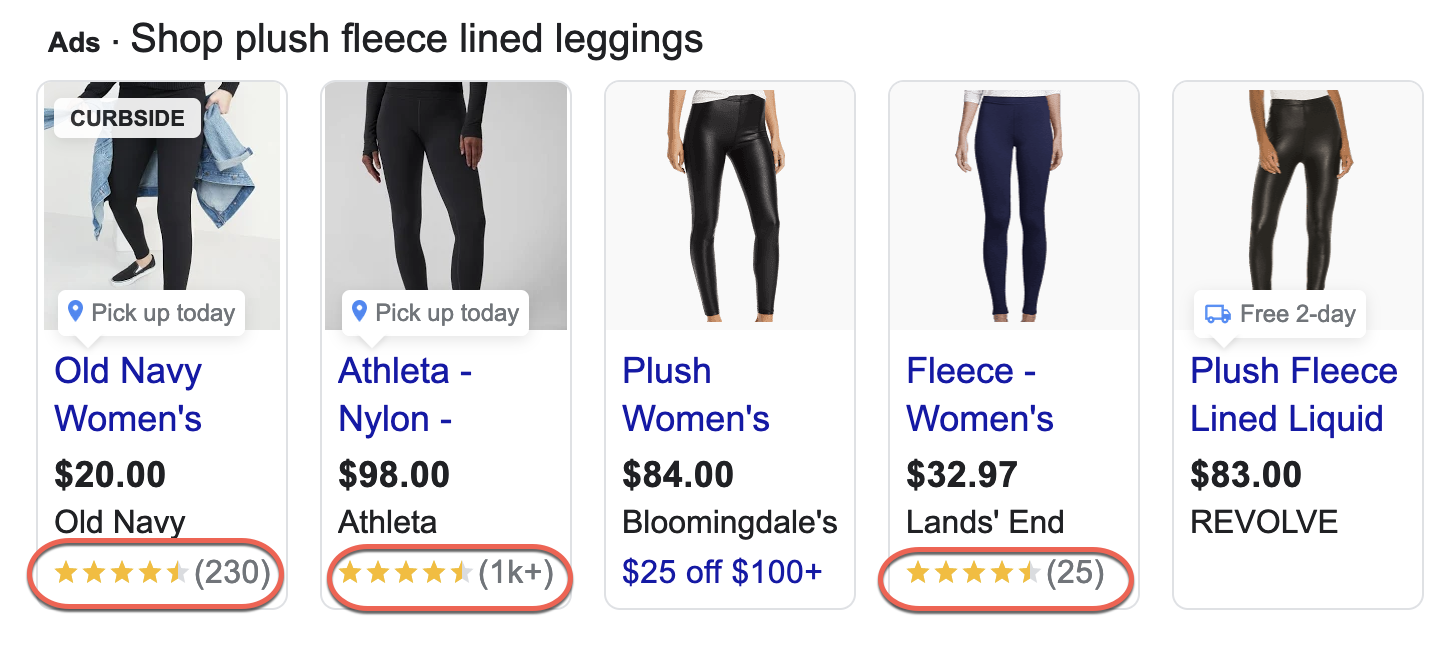You’ve probably seen seller ratings show up in Google advertising – or perhaps in organic search where they’re being tested.
They’re the one- to five-star ratings that sometimes display in search and shopping ads.
You may have wondered if these ratings are something you can (or should) add to your own Google Ads campaigns.
Unfortunately, not every advertiser is eligible to use seller ratings.
And while seller ratings technically don’t cost extra, the reality isn’t so simple.
Let’s take a closer look at seller ratings in Google advertising so you can decide whether they’re a good addition to your paid search marketing campaigns.
What Do Seller Ratings Look Like?
Let’s start by clarifying exactly what we mean by seller ratings.
Here’s an example of a shopping ad that includes them (ratings circled in red):
 Screenshot from Google, November 2021
Screenshot from Google, November 2021And here’s an example from a search text ad (ratings circled in red):
 Screenshot from Google, November 2021
Screenshot from Google, November 2021As you can see, sellers are rated on a scale of one to five stars. Google gathers these ratings from different sources that aggregate business reviews, such as Google itself and other organizations, such as Trustpilot.
The rating also includes the number of reviews the business or product has received.
Seller Ratings Are An Automated Extension
Seller ratings are an automated extension, so you have no control over when and how often Google will include them with your ads.
You can, however, decide not to apply them or remove them entirely, if you choose.
Based on our experience, seller ratings tend to impression with ads about one-third of the time (although this may vary widely from industry to industry).
Usually, you need to accumulate a minimum of 100 seller ratings within the past 12 months from a single country before this extension will impression at all.
Once you reach the 100-ratings mark, they should start showing up. Prepare to track performance so you can see if they’re having any impact.
Usually, we see these extensions show up very quickly once all the requirements are met, but others suggest the process can take up to six weeks.
As a safeguard, your seller ratings extension won’t impression if your rating falls below 3.5 stars.
So if a problem should arise that causes your ratings to fall, you don’t have to worry about one- or two-star ratings showing up with your ads.
How Much Do Seller Ratings Cost?
Here’s where things get a bit confusing.
According to Google, there’s no extra charge to use this extension. You’re only charged when people click on your ad, as usual.
But there’s more to the story.
It’s challenging for some advertisers to meet the requirement of accumulating a minimum of 100 reviews in the past 12 months.
Google will include its own Google customer reviews in its count, of course, but those might not be sufficient in number.
And so, most advertisers will have to work with a third-party vendor to collect customer reviews to reach those minimum thresholds.
Companies such as Trustpilot and Yotpo specialize in providing these kinds of services. Naturally, they charge a monthly fee for their services, which can add up.
Fees can vary based on demand and provider, so it’s worth shopping around to find a competitive price. (You can find a list of seller rating vendors here.)
Take Promises Of Results With A Grain of Salt
If you decide to look for a third-party ratings vendor to work with, take their hype with a grain of salt.
Some vendors will claim that including seller ratings extensions will increase ad rank, improve quality score and boost traffic by as much as 10%.
It seems unlikely that a single, simple ad extension can do all this – especially if you’re already doing well with ad rank, quality scores, etc.
Usually, obtaining such results requires a holistic approach to advertising that includes every tool in your arsenal, from ad formats to messaging to keywords.
Yes, seller rating ad extensions may have an important role to play.
But don’t expect them to do it all alone.
Should You Test Seller Rating Extensions?
Given everything we’ve covered, when should you enable seller rating extensions and test them out?
The answer is: it depends.
As alluded to above, we’ve never been able to draw a direct line from seller rating extensions to a higher CTR. The impact is never so pronounced or clear.
Still, that doesn’t mean seller ratings aren’t a good idea for some advertisers.
Here are some situations where it might sense to test seller rating extensions:
All Your Competitors Are Using Them
In some retail markets, almost every advertiser includes seller ratings in their ads.
Not having this extension may raise red flags with prospective buyers, so you better get onboard.
None Of Your Competitors Are Using Them.
If none of your competitors are using seller rating extensions, you may be able to use them as a way to stand out from the crowd.
They might be worth a shot.
You’re Competing With Big Box Brands
If you’re trying to stand up to big retail brands such as Home Depot, Costco or IKEA, seller ratings might be a good way to direct a bit of attention away from them and towards you.
In short, if you feel like seller ratings might give your ads a little boost, then give them a try.
If you don’t see any discernable lift from them, you can consider turning them off until things change and you’re ready to test them out again.
Seller Ratings: Another Tool In Your Marketing Arsenal
Every business and advertiser is different, so only you can decide whether seller ratings are worth testing in your Google Ads accounts.
Unfortunately, testing is made more complicated by the need for a minimum number of reviews.
Still, don’t let that extra burden put you off.
If you have a hunch that seller ratings might be a good fit for you and your business, give them a try!
More Resources:
- A Guide to Star Ratings on Google and How They Work
- Google Tests Seller Ratings in Organic Search
- Ecommerce Marketing: The Definitive Guide
Featured image: Viktoria Kurpas/Shutterstock





